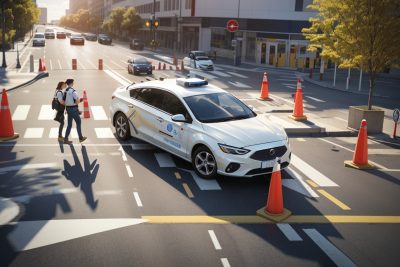With the proliferation of advanced safety features in modern vehicles, the driving experience has been revolutionized, making it safer than ever before.
One such feature that has gained significant traction is Autonomous Emergency Braking (AEB). Like a vigilant guardian, AEB acts as an active safety system, automatically applying the brakes in emergency situations to prevent or minimize collisions.
In this article, we delve into the various types of AEB systems, their functioning, and explore their critical role in saving lives and preventing accidents on the road.
Key Takeaways
- AEB is an active safety feature in cars that automatically applies the brakes in emergencies.
- There are different types of AEB, including forward AEB, rear AEB, AEB with pedestrian detection, city speed AEB, and highway speed AEB.
- AEB works by using a network of radar sensors and cameras to monitor the distance between the car and obstacles ahead.
- AEB is not currently compulsory in India, but some luxury and premium car brands offer it, and the government is considering making active safety features mandatory in the future.
The Benefits of Autonomous Emergency Braking
One of the key benefits of autonomous emergency braking is its ability to prevent or mitigate collisions by automatically applying the brakes, ensuring the safety of drivers and passengers.
This advanced safety feature uses sensors and cameras to detect obstacles and assess the risk of collision. If the system determines that a collision is imminent and the driver does not respond in time, the autonomous emergency braking system will take control and apply the brakes to avoid or reduce the impact of the collision.
This technology can significantly reduce the severity of accidents and potentially save lives.

Components of an AEB System
The components of an AEB system include radar sensors and cameras, which work in conjunction to detect obstacles and trigger the automatic braking function if necessary.
The radar sensors use radio waves to measure the distance between the car and objects in its path. They can detect the speed and direction of these objects, allowing the system to calculate the risk of a collision.
The cameras, on the other hand, use visual recognition technology to identify potential hazards, such as pedestrians, cyclists, or other vehicles.
By combining the information from both the radar sensors and cameras, the AEB system can accurately assess the situation and determine if emergency braking is required.
This advanced technology plays a crucial role in preventing accidents and protecting both the occupants of the vehicle and other road users.
How AEB Works in Different Driving Scenarios
Different driving scenarios, such as city traffic or high-speed highways, require the AEB system to adapt and respond accordingly, ensuring the safety of both the driver and other road users.
In city traffic, AEB can prevent rear-end collisions in bumper-to-bumper traffic by automatically applying the brakes if the driver fails to do so. This feature is particularly useful in heavy traffic or parking lots where sudden stops are common.
On high-speed highways, AEB uses advanced sensors to detect obstacles from a distance and can slow down the vehicle to avoid potential collisions. This is crucial in situations where a driver may not be able to react in time due to the high speed involved.
AEB’s Role in Preventing Collisions
Highlighting its crucial role, AEB actively prevents collisions by swiftly applying the brakes when obstacles are detected, ultimately enhancing road safety.
This advanced safety feature utilizes a combination of radar sensors and cameras to monitor the distance between the vehicle and potential obstacles.
If the distance reduces rapidly, AEB triggers a warning to the driver. If the driver fails to react in time, the system takes over and applies the brakes automatically.
The effectiveness of AEB lies in its quick reaction time, which surpasses human response time, and its ability to function in low visibility conditions, such as during night drives.
As AEB becomes more widely available in cars, it has the potential to significantly reduce the number of accidents and save lives on the road.
The Future of AEB Technology in Cars
As car manufacturers continue to innovate, the future of AEB technology in cars holds immense potential for enhancing road safety and reducing accidents.
Autonomous Emergency Braking (AEB) has already proven to be an effective safety feature, but advancements in technology are expected to further improve its capabilities. One area of development is the integration of artificial intelligence and machine learning algorithms, allowing AEB systems to better recognize and respond to various objects and scenarios on the road.
Additionally, the use of advanced sensors and cameras will enhance the accuracy and reliability of AEB systems. Furthermore, the future of AEB technology also involves the integration of vehicle-to-vehicle and vehicle-to-infrastructure communication, enabling cars to share information and coordinate actions to prevent collisions.
With these advancements, AEB technology will play a crucial role in ensuring safer roads and protecting the lives of drivers, passengers, and pedestrians.
Conclusion
In conclusion, Autonomous Emergency Braking (AEB) is a crucial safety feature in cars that has proven to be effective in preventing collisions and saving lives.
By automatically applying the brakes in emergency situations, AEB helps to mitigate the consequences of human error or distraction.
While some may argue that AEB systems can be expensive and add to the overall cost of the vehicle, the potential reduction in accidents and injuries outweighs the initial investment, making AEB a worthwhile addition to modern automobiles.
